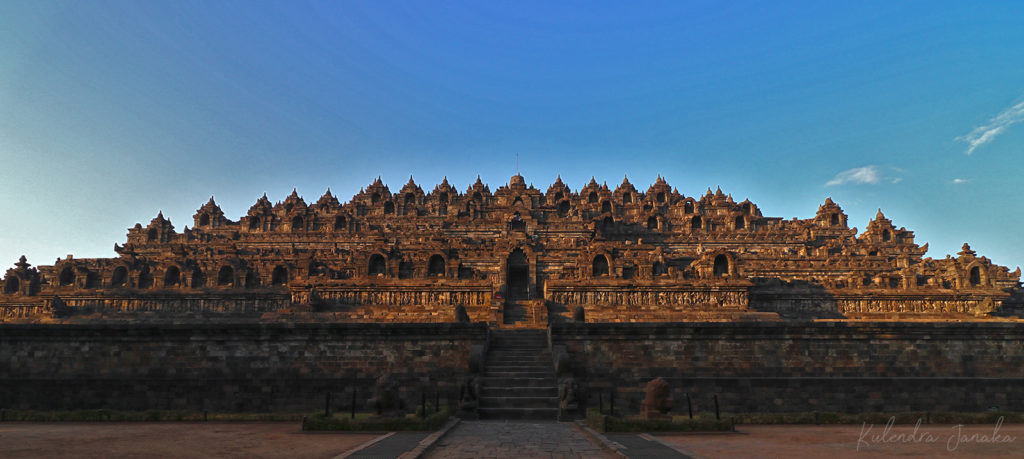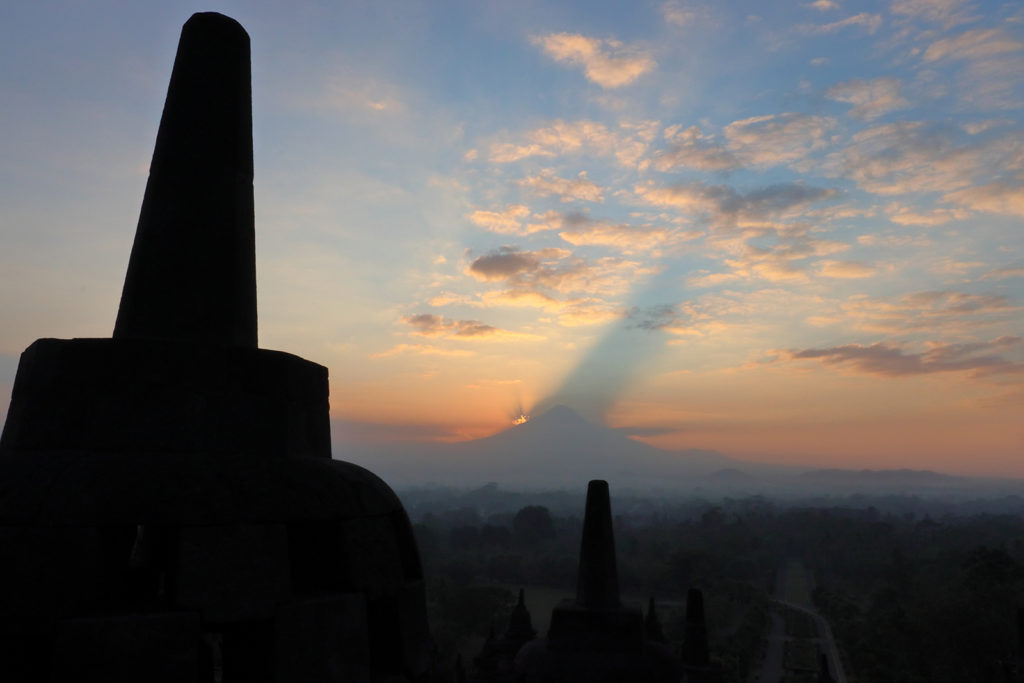Indonesia – Part 2: Borobudur
My visit to Yogyakarta, or Jogjakarta, or Jogja as most Indonesians call it, was motivated by its historical and cultural heritage. Yogyakarta is home to the world’s largest buddhist temple, Borobudur and the only Hindu temple that I knew at the time that was dedicated to all three of the trimurti, Prambanan. As I read more about the city, I found out that it is also home to Taman Sari, the water palace of the first Sultan of Jogjakarta. Prior to the occupation by the European colonial powers it was ruled by Hindu and Buddhist rulers followed by Muslim sultans. Jogjakarta would give the opportunity to explore a cross section of the history through three major eras.
Outside of the man-made history, Jogja also hosts some amazing natural beauties. Had I been a climber like my brother, I would’ve definitely planned to visit Goa Jomblang (Jomblang Cave), a 200ft deep (about 20-25 floors – let that number sink in) cave with an underground river. There is also Mount Merapi, an active volcano that last erupted in 2010. You can also visit the Jogan Beach where a small waterfall empties directly into the sea.
For my trip, I chose to visit Borobudur, Prambanan and Taman Sari. I was in luck when I figured out that I had chosen a lodging quite close to the Sonobudayo Museum where they have Wayang Kulit puppet shows several times a week.
Borobudur
Visiting Borobudur is not difficult at all, however as I learned through my trip throughout in Indonesia, you will not know what exactly it entails, until you get there.
My hotel was quite happy to point me towards a tour operator who was just one among tens of tour operators within that street! Had I walked to the main street, I would have been able to count over a hundred of them. But as it works like anywhere with this setup, prices quickly stabilise and you could actually choose any of the operators and will end up with the same outcome.
The operator I met explained to me that I could take a group tour or take a private tour. This is where I made my first mistake, without actually checking too much, I opted for the private tour. The tour to Borobudur would also cover a partial trip to Mount Merapi and Prambanan and will cost me 500,000 IDR. Each entrance would cost separately.
While the number looks pretty large, from a USD perspective it is not that big. At 14,000 IRD per USD, the tour comes to about 35-36 USD. Given that the total tour would cover around 120km total, it’s a pretty decent price.
Entrance ticket to Borobudur sunrise trek cost me 375,000 IDR. You are given a small torchlight if you are doing the sunrise tour and apparently the ticket also includes a free drink coupon at the Manohara restaurant, but I noticed it only much later when I headed off.
Borobudur is a Mahayana Buddhist temple which is also titled as the world’s largest temple. The entire structure that is now called Borobudur is considered to be one big stupa. The structure consists of nine floors and is divided into three zones; Kamadathu, Rupadathu and Arupadathu. Followers of Theravada Buddhism in my native country may notice that these correspond to the Kamavachara Loka, Rupavachara Loka and Arupavachara Loka. The top most level hosts the final stupa, which is thought to signify Nirvana.
History of Borobudur
The temple is thought to have been constructed in 800AD during the Sailendra Dynasty period. However who exactly ordered its construction or the construction methodology is still unknown. It is thought that during the later periods, volcanic eruptions and shifting of the capital to East Java would have caused Borobudur to be abandoned. When it was rediscovered in the 1880s, the area was apparently covered in vegetation and volcanic ashes. As Indonesia is also prone to earthquakes, they too may have caused damage to the structure, although the design having a large square base and the pyramidal nature would have helped it from being completely destroyed.
There had been at least one hypothesis about the temple being in the middle of a lake depicting a lotus born out of it. However soil analysis had shown that this proposal is without merit and the land has always remained a natural hill from the time of its construction.
Getting to Borobudur
My visit started around 4:30am from Malioboro Street where my hotel was. We managed to get to the location in less than an hour and started the “trek” immediately. While there are many posts on the internet that would advise you to start the trek early to avoid the rush, what they don’t tell you is just how many tourists could be found. By the time I got to the top level it may have been around 5:30-5:45 in the morning and over a hundred people were already at the top facing the east side, just waiting for the sunrise.
The sunrise itself is a pretty amazing experience. As what lies directly to the east and north east of Borobudur are the volcanic peaks of Mount Merapi and Mount Merbabu, you would be able to see the sun rise up from behind the mountains.
Once I was done shooting the sunrise, I took the liberty to walk around several levels of the structure. If you are a photographer, you are likely to find much better frames here whereas if you’d rather spend your time admire the art and culture, then you have thousands of carvings to keep you busy. Fortunately for me, many of the tourists seemed to be still busy at the top of the stupa or were only interested in checking out the carvings near the stairways.
Art and Architecture of Borobudur
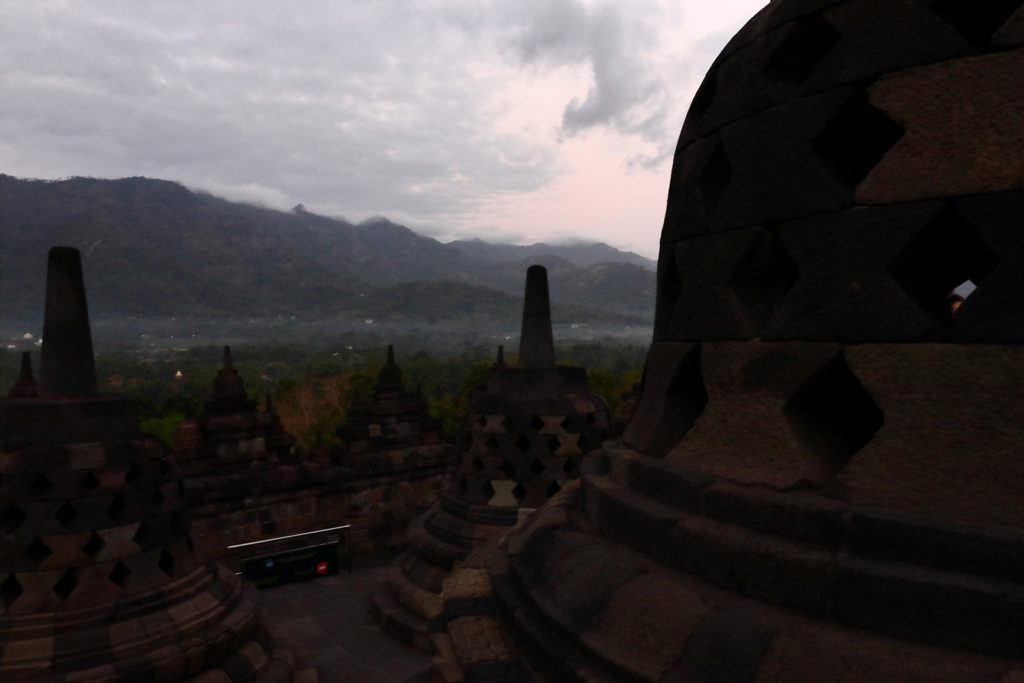
The stupa has three circular platforms which hosts 72 smaller stupas. 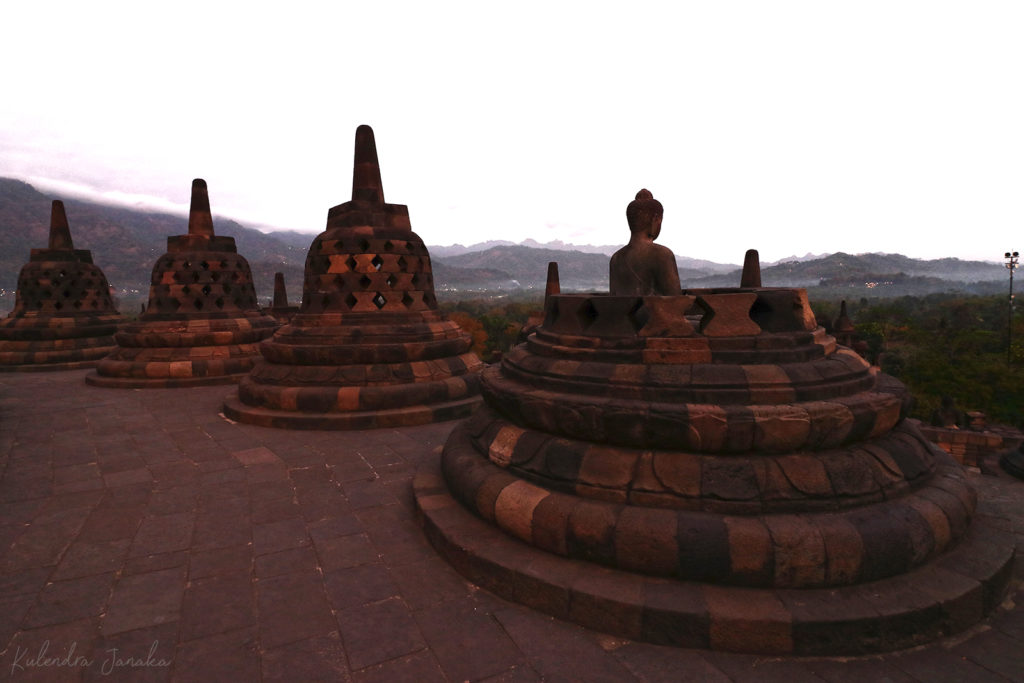
Each of the stupas enshrines a Buddha statue. 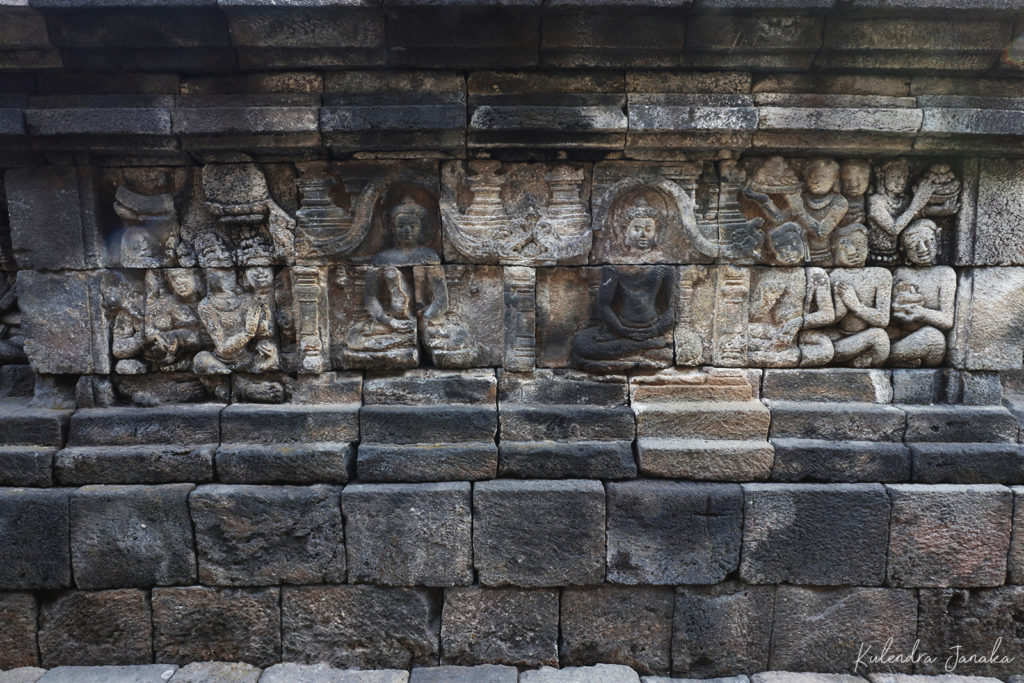
A small portion of the many bas-relief decorations. 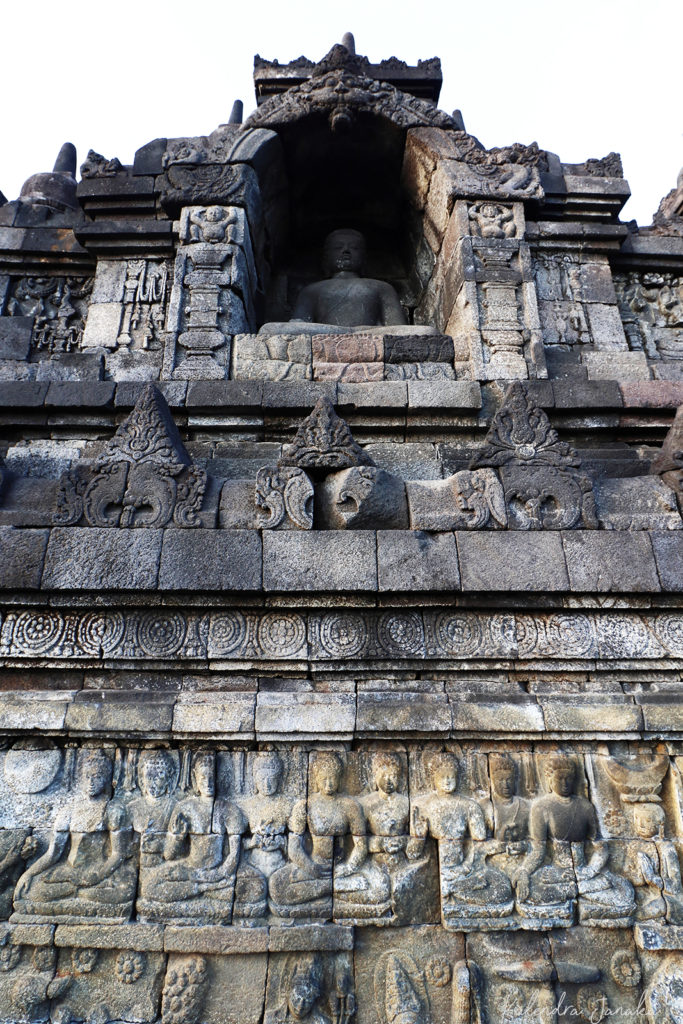
The lower levels of the stupa also hosts many Buddha status that are built in enclaves. 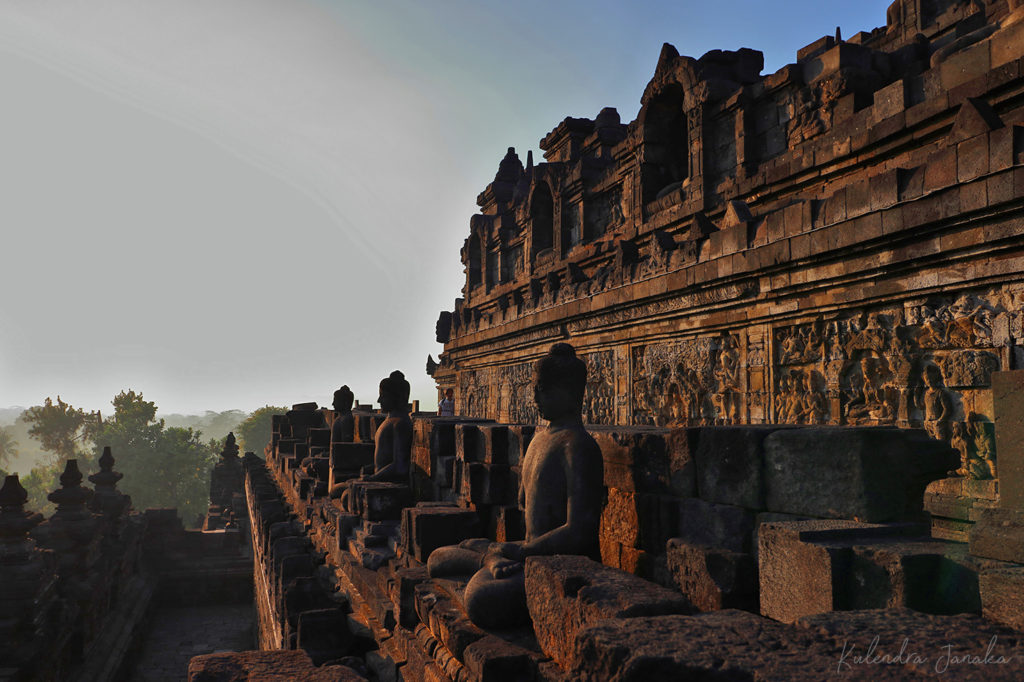
Borobudur at dawn. 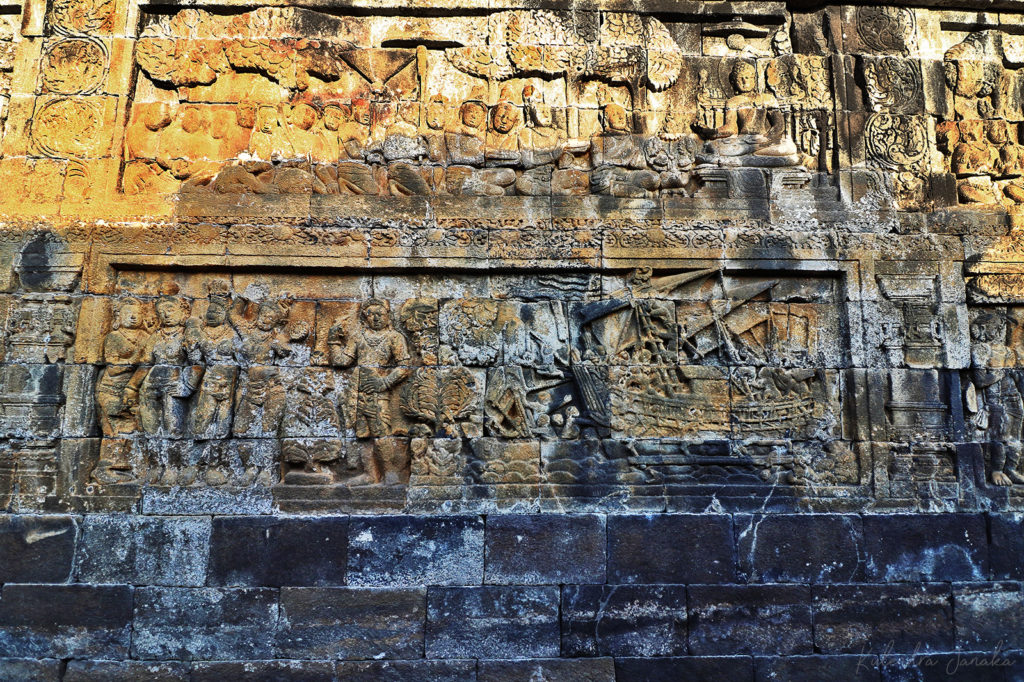
Some of the carvings have helped archeologists understand what type of technology the builders were familiar with.
The carving panels on Borobudur seem to cover a wide variety of subjects related to Mahayanik Buddhism. Some of these sources are common to other Buddhist sects as well. The carvings cover stories from Buddha’s own life, his previous lives (Jataka stories), some Buddhist teachings (Kamma vinhanga sutta and Gandavyuha sutra – the latter being exclusive to Mahayanik sect) and some stories attached to Buddhism (Apadana or Avadana stories). It seems that when the archaeologists determined that the stupa was built as three sections depicting kamadatu, rupadatu and arupadatu, they drew some of their conclusions from the carvings as well.
The top most levels of the stupa consists of three circular platform that hosts a total of 72 smaller stupas. Enshrined in these stupas are statues of Buddha in various meditative forms. There are several stupas with the top part disassembled to provide an unobstructed view of the statues.
As the Sun started to get further up in the sky, I walked back to my vehicle to follow on to my next destination, Mount Merapi.
